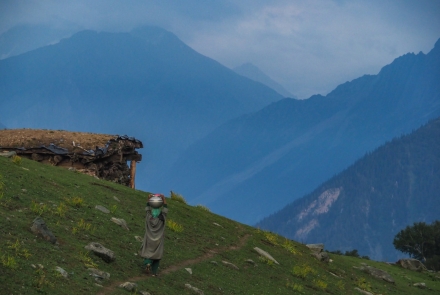
Photo by Leslie Derksen on Unsplash
Conducting feminist research during lockdown
The COVID-19 pandemic is now a worldwide social, economic, and political crisis, but not everyone is affected in the same way, Kuntala Lahiri-Dutt, Arnab Chakraborty, and Sourav Bag write.
The severity of COVID-19’s effect differs by race/ethnicity, age, and gender, and reports suggest that some women have been hit more than the others, with those who are also poor or disadvantaged in other ways experiencing the worst outcomes.
So how do the intersectional identities of women determine their experience of COVID-19, and how can qualitative researchers now continue to engage with research participants in remote communities to know if they are coping well? International travel restrictions prevent us from flying, and the lockdown in India rules out field visits, but there are other ways to do this.
Rapid Phone Appraisal (RPA) is a tool that allows researchers to investigate, from the perspective of intersectionality, how women are coping with the impacts of COVID-19 on their food security. In implementing RPA, we chose Chakadoba, one of the most remote villages in India, 44 kilometres from Bankura town, a district headquarters in West Bengal. We used the tool to ask women about their experience of COVID-19 and its impact on their lives and livelihoods.
The results of the study are still coming in, but a look at its methods can explain the usefulness RPA to researchers who cannot visit their ‘field’ but still need data.
Rapid appraisals have a long history of application in social science research, and the RPA draws on participatory rural appraisal (PRA) –a range of approaches, methods and tools used by field researchers to encourage local communities to analyse and assess diverse local conditions. Development researcher Robert Chambers drew on his 1980 concept of Rapid Rural Appraisal to popularise PRA in the early 1990s.
Participatory rural appraisal aims to include perspectives, knowledges, and preferences in a bottom-up approach to development that creates an interactive learning environment, and many modifications have been made to PRA since the 1990s. Citizen science, for example, has been widely used in development research to replace the credentialed, professional experts – who previously displaced the ‘learned amateurs’.
RPA relies on the survey population’s access to a mobile phone, so only those women with access to a phone and willingness to participate in the study were included.
This sampling frame is sensible and practical; in fact, the feminist philosopher of science Sandra Harding calls this kind of research as having ‘strong objectivity’.
But how does one conduct phone research with rural women? Phones are used widely in social research. Land phones were used in the 1990s for market research, but now, mobile phones add a new dimension to data collection.
Within India, the use of mobile phones has grown exponentially, making it a good environment for RPA. This technological innovation has been revolutionary in its effect on culture, relations, business, governments, social mobility, and politics – as ANU scholars write in The Great Indian Phonebook – and helped make this research possible.
Chakadoba is home to indigenous farming communities, and since there is no road to the village, one has to get a bicycle to reach it. The land is of four types: tanr (upland), baidh (medium upland), kanali (medium lowland), and shol (lowland), but only kanali and shol are cultivated for more assured production. Monsoon-reliant, rain-fed dhaan (paddy) is grown on more than half the land, and small amounts of tomatoes, potatoes, and vegetables.
The village has three hamlets: Adibasipara, Raipara, and Mudipara. Adibasipara is home to seven indigenous tribal communities – Mandi, Murmu, Soren, Baskey, Hansda, Tuddu, and Hembram. Lower-caste Hindus live in the other hamlets. There are 77 households in the village, and 90 per cent of them are engaged in agriculture.
Most of the produce produced in Chakadoba is consumed locally and households sell only a small portion in good harvest years. The villagers are always cash-strapped. For over 60 years now, many have migrated during the dry, lean season to other districts or towns to work as labourers to earn a cash income in road or building construction, factories, or agro-processing units.
The primary challenge for RPA – getting access to women – was resolved by the non governmental organisation Professional Assistance for Development Action (PRADAN). PRADAN has been involved with service delivery in the village for several years, and The Australian Centre for International Agricultural Research also funded research there.
Within a household, access to a phone depends on power, and the research followed a simple protocol to ensure access.
We used our network to locate women who were involved with PRADAN through its development projects. We were mindful of each individual woman’s caste, class, ethnicity, age, and family background in selecting who was spoken to. A person familiar with the participant made the initial call to assess her access to the phone. The caller sought the woman’s verbal consent, and made an appointment for the hour-long conversation. They also requested the participant to find a private place to speak with us at ease.
About an hour before the call, we sent a reminder by another phone call. We made the call at the appointed time, once again explaining the purpose and aim of the study. We told them we would be recording the conversation, and that they had the right to stop at any point.
Once in contact with the women, we asked a series of short questions, completed the conversation, and asked for a response.
The questions centred on women’s jobs on a regular day before the pandemic. Once they felt comfortable talking about it, we also asked about their knowledge of COVID-19 – its symptoms, the mode of spread, and how to stay safe.
Then followed a discussion on practices – how they maintain social distancing and ensure the safety of themselves and family members. We also asked them to what extent villagers follow these measures.
We then spoke about the aspects of their life that have changed (and that have not), how they perceive and prioritise risks, their biggest worry now (as against in the past) as they confront the impact of the lockdown on physical and mental well-being. We discussed the impacts of the lockdown on livelihoods by exploring why they have been affected, and how much and in what ways.
The research was attempting to identify what women perceive to be their biggest concerns and why. What could be done to address it? This can then help policymakers address their issues. If they discussed how they envisioned the future for themselves, their family, and their village or community, we asked what policies or steps could help them.
There was also some hope that the conversations would provide some insight into domestic violence, but as it is a sensitive topic, it was discussed only if women were willing to go beyond yes/no answers.
RPA as a research tool is rapid and participatory; researchers who cannot visit the field should find it a useful and reliable tool for situations where physical accessibility to the field is restricted. The process of using the RPA is designed to be easy, simple, and practicable, with ‘participatory’ and ‘rapid’ being its two key characteristics.
The research in Chakadoba showed that RPA is a replicable tool for researchers who are involved in conducting development-focused action-research projects. While it was limited to one small village, the study trialed the tool successfully, and the information gathered by RPA was reliable.
However, baseline information on households is required to correctly use RPA to conduct research, in order for researchers to understand how differences in responses are linked to differences in age, economic class, caste, landownership, and family structures in which women live.
Generally, women emphasised three broad areas specific to their caste, ethnicity, age, and class locations as important to them. These include knowledges and perceptions; their everyday practices, around livelihoods, water, and food, and their interests arising from them; and their vision of the future. We found great amounts of overlap between the practical aspects of a woman’s life and the strategic aspects – that is, their overall ability to access a livelihood.
What was most clear is that individuals’ experiences lie at the crossroads of their caste, class, ethnicity, age and other factors. This raises a crucial question for policymakers: What implications do these differences have for development, research, and policy-making overall?
While this use of RPA was at an historic and disastrous moment of crisis, it helped to ask a broader, and critical, question: Can policy-making and research begin to consider women’s identities as individuals – and not as a singular, homogeneous community – in planning developmental interventions?
And how can we use tools like RPA to rethink developmental interventions, and consider the different perspectives of individual women when making decisions that affect them?
After this crisis wanes, the policy implications of the Chakadoba study could help create a feminist plan to help rural communities to recover from this shock and build resilience, and build a path to better research for the future.
Updated: 29 June 2024/Responsible Officer: Crawford Engagement/Page Contact: CAP Web Team













